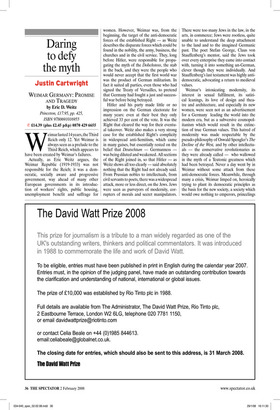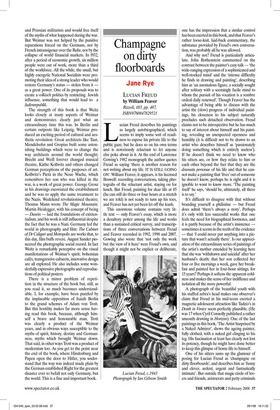Daring to defy the myth
Justin Cartwright
WEIMAR GERMANY: PROMISE AND TRAGEDY by Eric D. Weitz Princeton, £17.95, pp. 425, ISBN 9780691016955 ✆ £14.39 (plus £2.45 p&p) 0870 429 6655 Weimar lasted 14 years, the Third Reich only 12. Yet Weimar is always seen as a prelude to the Third Reich, which appears to have been created by Weimar’s failures.
Actually, as Eric Weitz argues, the Weimar Republic (1919-1933) was not responsible for the Reich; it was a democratic, socially aware and progressive government, way ahead of many other European governments in its introduction of workers’ rights, public housing, unemployment benefit and suffrage for women. However, Weimar was, from the beginning, the target of the anti-democratic forces of the established Right — as Weitz describes the disparate forces which could be found in the nobility, the army, business, the churches and in the civil service. They, long before Hitler, were responsible for propagating the myth of the Dolschstoss, the stab in the back, and they were the people who would never accept that the first world war was the product of German militarism. In fact it suited all parties, even those who had signed the Treaty of Versailles, to pretend that Germany had fought a just and successful war before being betrayed.
Hitler and his party made little or no impression on the German electorate for many years: even at their best they only achieved 33 per cent of the vote. It was the Right that cleared the way for their eventual takeover. Weitz also makes a very strong case for the established Right’s complicity in widespread anti-Semitism, which came in many guises, but essentially rested on the belief that Deutschtum — Germanness — was being diluted and weakened. All sections of the Right joined in, so that Hitler — as Weitz shows all too clearly — said absolutely nothing that the Right had not already said. From Prussian nobles to intellectuals, from civil servants to poets, there was a widespread attack, more or less direct, on the Jews. Jews were seen as purveyors of modernity, corrupters of morals and secret manipulators. There were too many Jews in the law, in the arts, in commerce; Jews were rootless, quite unable to understand the deep attachment to the land and to the imagined Germanic past. The poet Stefan George, Claus von Stauffenberg’s mentor, said the Jews took over every enterprise they came into contact with, turning it into something un-German, clever though they were individually. And Stauffenberg’s last testament was highly antidemocratic, advocating a return to medieval values.
Weimar’s intoxicating modernity, its interest in sexual fulfilment, its satirical leanings, its love of design and theatre and architecture, and especially its new women, were seen not as an advertisement for a Germany leading the world into the modern era, but as a subversive cosmopolitanism which would result in the extinction of true German values. This hatred of modernity was made respectable by the pseudo-philosophy of Oswald Spengler’s The Decline of the West, and by other intellectuals — the conservative revolutionaries as they were already called — who wallowed in the myth of a Teutonic greatness which had been betrayed. Never a day went by in Weimar without some attack from these anti-democratic forces. Meanwhile, through many a crisis, Weimar limped on, heroically trying to plant its democratic principles as the basis for the new society, a society which would owe nothing to emperors, princelings and Prussian militarists and would free itself of the myths of what happened during the war. But Weimar was not helped by the punitive reparations forced on the Germans, nor by French intransigence over the Ruhr, nor by the collapse of world financial markets. In l932, after a period of economic growth, six million people were out of work, more than a third of the workforce. All the while, the small, but highly energetic National Socialists were promoting their idea of a strong leader who would restore Germany’s status — stolen from it — as a great power. One of its proposals was to create a volkisch politics by restricting Jewish influence, something that would lead to a Judenrepublik.
The strength of this book is that Weitz looks closely at many aspects of Weimar and demonstrates clearly just what an extraordinary time this was. In Berlin and certain outposts like Leipzig, Weimar produced an exciting period of cultural and aesthetic revolution. Great architects like Taut, Mendelsohn and Gropius built some astonishing buildings which were to change the way architects around the world thought; Brecht and Weill forever changed musical theatre, Käthe Kollwitz and others changed German perceptions of the purposes of art. Kollwitz’s Pietà in the Neue Wache, which remembers her son who was killed in the war, is a work of great power. George Grosz in his drawings excoriated the establishment and he was to apply the same treatment to the Nazis. Wedekind revolutionised theatre; Thomas Mann wrote The Magic Mountain; Martin Heidegger, with his concept of being — Dasein — laid the foundations of existentialism, and his work is still influential despite the fact that he was a Nazi. Germany led the world in photography and film: The Cabinet of Dr Caligari and Metropolis are works that, to this day, film buffs revere. August Sander pioneered the photographic social record. In fact Weitz is remarkably perceptive on the visual manifestations of Weimar’s spirit; bohemian cafés, transgressive cabarets, innovative design are all explored. He also includes some wonderfully expressive photographs and reproductions of political posters.
There is a minor problem of repetition in the structure of the book but, still, as you read it, so much becomes understandable. I, for example, have been puzzled by the implacable opposition of Isaiah Berlin to the grand schemes of Adam von Trott. But this hostility makes far more sense having read this book, because, although himself a brave and honourable man, Trott was clearly a product of the Weimar years, and in obvious ways susceptible to the myths of spirit, history, destiny and Germanness, myths which brought Weimar down. That said, in other ways Trott was a product of modernism too. As you get to the point near the end of the book, where Hindenburg and Papen open the door to Hitler, you understand that the way was indeed made plain by the German established Right for the greatest disaster ever to befall not only Germany, but the world. This is a fine and important book.



































































 Previous page
Previous page